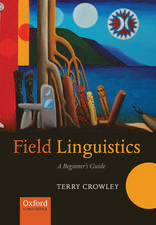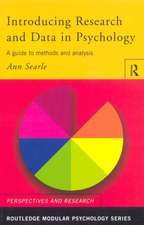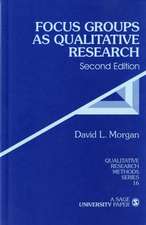Handbook of Quantitative Criminology
Editat de Alex R. Piquero, David Weisburden Limba Engleză Paperback – 9 aug 2011
| Toate formatele și edițiile | Preț | Express |
|---|---|---|
| Paperback (1) | 725.42 lei 6-8 săpt. | |
| Springer – 9 aug 2011 | 725.42 lei 6-8 săpt. | |
| Hardback (1) | 979.84 lei 6-8 săpt. | |
| Springer – 13 ian 2010 | 979.84 lei 6-8 săpt. |
Preț: 725.42 lei
Preț vechi: 853.44 lei
-15% Nou
Puncte Express: 1088
Preț estimativ în valută:
138.83€ • 144.40$ • 114.61£
138.83€ • 144.40$ • 114.61£
Carte tipărită la comandă
Livrare economică 15-29 aprilie
Preluare comenzi: 021 569.72.76
Specificații
ISBN-13: 9781461413882
ISBN-10: 1461413885
Pagini: 804
Ilustrații: XIII, 787 p. 94 illus.
Dimensiuni: 178 x 254 x 45 mm
Greutate: 1.37 kg
Ediția:2010
Editura: Springer
Colecția Springer
Locul publicării:New York, NY, United States
ISBN-10: 1461413885
Pagini: 804
Ilustrații: XIII, 787 p. 94 illus.
Dimensiuni: 178 x 254 x 45 mm
Greutate: 1.37 kg
Ediția:2010
Editura: Springer
Colecția Springer
Locul publicării:New York, NY, United States
Public țintă
GraduateCuprins
Descriptive Approaches for Research and Policy: Innovative Descriptive Methods for Crime and Justice Problems.- Crime Mapping: Spatial and Temporal Challenges.- Look Before You Analyze: Visualizing Data in Criminal Justice.- Group-Based Trajectory Modeling: An Overview.- General Growth Mixture Analysis with Antecedents and Consequences of Change.- Spatial Regression Models in Criminology: Modeling Social Processes in the Spatial Weights Matrix.- Mixed Method Research in Criminology: Why Not Go Both Ways?.- Descriptive Approaches for Research and Policy: New Estimation Techniques for Assessing Crime and Justice Policy.- Estimating Costs of Crime.- Estimating Treatment Effects: Matching Quantification to the Question.- Meta-analysis.- Social Network Analysis.- Systematic Social Observation in Criminology.- New Directions in Assessing Design, Measurement and Data Quality.- Identifying and Addressing Response Errors in Self-Report Surveys.- Missing Data Problems in Criminological Research.- The Life Event Calendar Method in Criminological Research.- Statistical Power.- Descriptive Validity and Transparent Reporting in Randomised Controlled Trials.- Measurement Error in Criminal Justice Data.- Statistical Models of Life Events and Criminal Behavior.- Estimation of Impacts and Outcomes of Crime and Justice: Topics in Experimental Methods.- An Introduction to Experimental Criminology.- Randomized Block Designs.- Construct Validity: The Importance of Understanding the Nature of the Intervention Under Study.- Place Randomized Trials.- Longitudinal-Experimental Studies.- Multisite Trials in Criminal Justice Settings: Trials and Tribulations of Field Experiments.- Estimation of Impacts and Outcomes of Crime and Justice: Innovation in Quasi-Experimental Design.- Propensity Score Matching in Criminology and Criminal Justice.- Recent Perspectives on the Regression Discontinuity Design.- Testing Theories of Criminal Decision Making: Some Empirical Questions about Hypothetical Scenarios.- Instrumental Variables in Criminology and Criminal Justice.- Estimation of Impacts and Outcomes of Crime and Justice: Non-Experimental Approaches to Explaining Crime and Justice Outcomes.- Multilevel Analysis in the Study of Crime and Justice.- Logistic Regression Models for Categorical Outcome Variables.- Count Models in Criminology.- Statistical Analysis of Spatial Crime Data.- An Introduction to Statistical Learning from a Regression Perspective.- Estimating Effects over Time for Single and Multiple Units.
Notă biografică
Alex R. Piquero is a Professor at the University of Maryland Department of Criminal Justice and Criminology, Member of the MacArthur Foundation's Research Network on Adolescent Development, and Member of the National Consortium on Violence Research. He is also Executive Counselor of the American Society of Criminology, and is Co-Editor of the Journal of Quantitative Criminology. He received a Ph.D. in Criminology & Criminal Justice from the University of Maryland in 1996, and has received several teaching, research, and mentoring awards, including the American Society of Criminology Young Scholar and E-Mail Mentor of the Year Awards, and a University of Florida Teacher of the Year Award. His research interests include criminal careers, criminological theory, and quantitative research methods. He has published widely in the fields of criminology, criminal justice, psychology, and sociology, and is co-author (with Alfred Blumstein and David Farrington) of a recently published book, Key Issues in Criminal Careers Research.
David Weisburd is Walter E. Meyer Professor of Law and Criminal Justice and Director of the Institute of Criminology at the Hebrew University Faculty of Law, and Distinguished Professor of Administration of Justice at George Mason University. He is an elected Fellow of the American Society of Criminology and of the Academy of Experimental Criminology. He is also Co-Chair of the steering committee of the Campbell Collaboration Crime and Justice Group, a member of the Harvard University/National Institute of Justice Executive Session in Policing, and of the National Research Council Committee on Crime, Law and Justice. Professor Weisburd has a long interest in Crime and Place studies beginning with his involvement in a series of experimental studies of police interventions at crime places, including the Minneapolis Hot Spots Experiment, the Jersey City Drug Market Analysis Experimentand the Jersey City Violent Crime Hot Spots Experiment. Professor Weisburd is presently working on a book with Liz Groff and SueMing Yang that explores the varying factors that explain variation in developmental trends of crime at micro places over time that will be published by Oxford University Press. Professor Weisburd is author or editor of fifteen books and more than eighty scientific articles.
David Weisburd is Walter E. Meyer Professor of Law and Criminal Justice and Director of the Institute of Criminology at the Hebrew University Faculty of Law, and Distinguished Professor of Administration of Justice at George Mason University. He is an elected Fellow of the American Society of Criminology and of the Academy of Experimental Criminology. He is also Co-Chair of the steering committee of the Campbell Collaboration Crime and Justice Group, a member of the Harvard University/National Institute of Justice Executive Session in Policing, and of the National Research Council Committee on Crime, Law and Justice. Professor Weisburd has a long interest in Crime and Place studies beginning with his involvement in a series of experimental studies of police interventions at crime places, including the Minneapolis Hot Spots Experiment, the Jersey City Drug Market Analysis Experimentand the Jersey City Violent Crime Hot Spots Experiment. Professor Weisburd is presently working on a book with Liz Groff and SueMing Yang that explores the varying factors that explain variation in developmental trends of crime at micro places over time that will be published by Oxford University Press. Professor Weisburd is author or editor of fifteen books and more than eighty scientific articles.
Textul de pe ultima copertă
The Handbook of Quantitative Criminology is designed to be the authoritative volume on methodological and statistical issues in criminology and criminal justice. At a time when this field is gaining in sophistication and dealing with ever more complex empirical problems, this volume seeks to provide readers with a clear and up to date guide to quantitative criminology. Authored by leading scholars in criminology/criminal justice, the Handbook contains 35 chapters on topics in the following key areas: (1) research design, (2) experimental methods, (3) methods for overcoming data limitations, (4) innovative descriptive methods, (5) estimation techniques for theory and policy, (6) topics in multiple regression, and (7) new directions in statistical analysis. The contributions are written to be accessible to readers with a basic background in statistics and research methods, but they also provide a cutting edge view of statistical and methodological problems and questions. This book will be the go-to book for new and advanced methods in the field that will provide overviews of the key issues, with examples and figures as warranted, for students, faculty, and researchers alike.
Caracteristici
Will serve as the 'go-to' book for students, faculty, and researchers alike working in criminology/criminal justice An important and much needed contribution to the field Provides comprehensive coverage of the issues, methods, and future directions in quantitative criminology in one collection Includes supplementary material: sn.pub/extras















